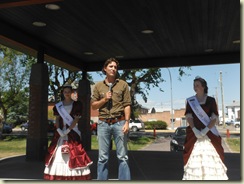A retired reporter remembers his many contacts with the Trudeau legend
Perceptions by Gerry Warner
Seeing Justin Trudeau in Cranbrook’s Rotary Park last week sure brings back the memories and raises some intriguing political questions as well. But let’s start with the memories first.
Memories? Well, this old fart, retired reporter goes back a long way with the Trudeau’s. Way back in the fall of 1965, I shared a SFU political science class with Justin’s  mother, the inestimable Margaret Sinclair or “Maggie” Trudeau as she later came to be known. She wasn’t famous then. Her sister Rosalind was better known and considered by many to be more beautiful. But then Maggie met Pierre and many of you know the rest of that Gothic tale. Cue the Rolling Stones and Studio 54.
mother, the inestimable Margaret Sinclair or “Maggie” Trudeau as she later came to be known. She wasn’t famous then. Her sister Rosalind was better known and considered by many to be more beautiful. But then Maggie met Pierre and many of you know the rest of that Gothic tale. Cue the Rolling Stones and Studio 54.
Then there the 1980’s when I covered Pierre several times when he passed through Kamloops on campaign stops. The most memorable of these was when he was speaking at the old KXA barn which passed for a convention centre in Kamloops in those days. Turns out Pierre had an old Trudeau cousin that lived in Kamloops who they hauled on stage to shake his hand before he spoke. As luck would have it, I was on the stage too about 20 feet away with my notebook and trusty old, Russian camera when the cousin stumbled as he was reaching to shake Pierre’s hand and fell dead at his feet of a massive coronary.
Needless to say all hell broke loose.
We had a photographer there but I was closer so I felt I better get a shot or my editor would have fired me the next day. (not an imaginary possibility) So I took a few steps closer and took a couple quick pics of the poor old gentleman on the floor as Trudeau’s handlers moved in threatening to punch me out. I got the hell out of there only to read quotes in the Globe and Mail the next day from the same Liberal heavies denouncing me as a “ghoul.” There was some truth to that.
Anyway, a few years later Trudeau passed through Kamloops again on another campaign and I was writing up a story on his brief stop when a story crackled over the wire that he had raised his middle, index finger to a crowd that was heckling him at a Salmon Arm railway platform. (Those were the good ol’ days when politicians still campaigned on trains and had the courage to make unscripted gestures. Sigh!)
Many years pass and I’m toiling in the trenches for the Cranbrook Daily Townsman when publisher Steen Jorgenson was kind enough to send me and the good wife to the Chateau Lake Louise to cover young Justin Trudeau and his then fiancé Sophie Gregoire who were appearing at an avalanche awareness seminar after the tragic death of Justin’s brother Michel at the age of 23 in Kokanee Glacier Provincial Park. Justin wasn’t yet an MP at the time but it was obvious he was getting ready for a career in politics. I was introduced to him and we got to talking about a lot of things including the bizarre incident with the death of his father’s cousin in Kamloops. Justin said Pierre was quite shaken up by the incident and told him at the tender age of 10 or so there was a political lesson to be learned from it – no more “add on’s” at campaign stops.
A few years later, I was hiking in Kokanee Park on the same trail where the avalanche swept away Michel Trudeau to his death Nov. 16, 1998, a day before my birthday. I have to admit it gave me a very spooky feeling to think of his body in the frigid, glacier water just below my feet. It’s very sad to think of the annual pilgrimage members of the Trudeau family make every year to mark his demise.
But life endures and now it’s Justin carrying the heavy banner of the Trudeau legend. Will he become the first Prime Minister’s son in Canada to succeed his father as the nation’s political leader?
Naturally there’s no way of knowing, but on a hot Sunday afternoon in Cranbrook’s Rotary Park Justin Pierre James Trudeau showed every sign his celebrated father’s charisma still burns.
-- 30 –-
Gerry Warner is a retired journalist and Cranbrook City Councillor. His opinions are his own.

